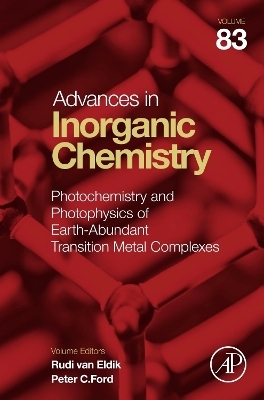
Photochemistry and Photophysics of Earth-Abundant Transition Metal Complexes
Academic Press Inc (Verlag)
978-0-443-23746-1 (ISBN)
Rudi van Eldik was born in Amsterdam (The Netherlands) in 1945 and grew up in Johannesburg (South Africa). He received his chemistry education and DSc degree at the former Potchefstroom University (SA), followed by post-doctoral work at the State University of New York at Buffalo (USA) and the University of Frankfurt (Germany). After completing his Habilitation in Physical Chemistry at the University of Frankfurt in 1982, he was appointed as Professor of Inorganic Chemistry at the Private University of Witten/Herdecke in 1987. In 1994 he became Professor of Inorganic and Analytical Chemistry at the University of Erlangen-Nürnberg, from where he retired in 2010. At present he is Professor of Inorganic Chemistry at the Jagiellonian University in Krakow, Poland, and Visiting Professor of Inorganic Chemistry at the N. Copernicus University in Torun, Poland. His research interests cover the elucidation of inorganic and bioinorganic reaction mechanisms, with special emphasis on the application of high pressure thermodynamic and kinetic techniques. In recent years his research team also focused on the application of low-temperature rapid-scan techniques to identify and study reactive intermediates in catalytic cycles, and on mechanistic studies in ionic liquids. He is Editor of the series Advances in Inorganic Chemistry since 2003. He serves on the Editorial Boards of several chemistry journals. He is the author of over 880 research papers and review articles in international journals and supervised 80 PhD students. He has received honorary doctoral degrees from the former Potchefstroom University, SA (1997), Kragujevac University, Serbia (2006), Jagiellonian University, Krakow, Poland (2010), University of Pretoria, SA (2010), and Ivanovo State University of Chemistry and Technology, Russia (2012). He has developed a promotion activity for chemistry and related experimental sciences in the form of chemistry edutainment presentations during the period 1995-2010. In 2009 he was awarded the Federal Cross of Merit (‘Bundesverdienstkreuz’) by the Federal President of Germany, and the Inorganic Mechanisms Award by the Royal Society of Chemistry (London). His hobbies include music, hiking, jogging, cycling and motor-biking. He is the father of two and grandfather of four children. Peter C. Ford is at the Department of Chemistry and Biochemistry, University of California Santa Barbara, CA, USA.
1. Radioluminescence of Copper(I) Clusters Peter C. Ford 2. Photophysics and Photochemistry of Chromium(III) Complexes (Molecular Rubies) Katja Heinze 3. Chromic behaviors of luminescent copper(I) complexes Masako Kato 4. Long-lived photoluminescence in group metal complexes enabled by ligand-to-metal charge transfer Carsten Milsmann 5. Photoactive MOFs for CO2 Activation utilizing Earth Abundant Metals Amanda Morris 6. Earth Abundant Metal Complexes for Optoelectronic Applications Mark Thompson 7. Photoactive metal to ligand charge transfer excited states in 3d6 and 3d8 complexes Oliver Wenger 8. Ligand-to-metal charge-transfer excited states in d0 transition-metal complexes: Investigations into the photochemistry and photophysics of emissive titanocenes Paul Wagenknecht 9. Ultrafast dynamics in photoactive copper complexes from optical and Xray methods Julia Weinstein 10. Photophysical properties of Ni(II) complexes and some copper(I) and zinc(II) complexes Vivian Yam
| Erscheinungsdatum | 04.06.2024 |
|---|---|
| Reihe/Serie | Advances in Inorganic Chemistry |
| Verlagsort | San Diego |
| Sprache | englisch |
| Maße | 152 x 229 mm |
| Gewicht | 660 g |
| Themenwelt | Naturwissenschaften ► Chemie ► Anorganische Chemie |
| Naturwissenschaften ► Chemie ► Organische Chemie | |
| Naturwissenschaften ► Chemie ► Physikalische Chemie | |
| ISBN-10 | 0-443-23746-8 / 0443237468 |
| ISBN-13 | 978-0-443-23746-1 / 9780443237461 |
| Zustand | Neuware |
| Informationen gemäß Produktsicherheitsverordnung (GPSR) | |
| Haben Sie eine Frage zum Produkt? |
aus dem Bereich


